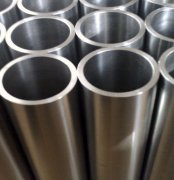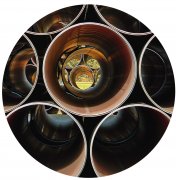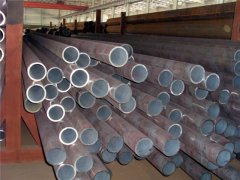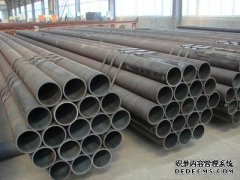Specifications: diameter: 320 to 127 mm thickness: 0.4 to 12.7 mm Length: 6 m above, and, in accordance with customer demand, supply and other specifications of steel pipe
Pipes Catalog
 Seamless steel pipe
Seamless steel pipe- pipeline
- OCTG
- ASTM pipe
- API pipe
- Heavy Wall Steel Pipe
- Boiler steel pipes
- Casing and tubing
 Welded steel pipe
Welded steel pipe- spiral steel pipe
- ERW pipe
- SSAW pipe
- DSAW pipe
- LSAW pipe
 Carbon steel pipe
Carbon steel pipe- Black steel pipe
- fluid pipe
- Pipeline Coating,2PE 3PE
- Structural steel pipe
- Mild Steel Pipe
 Alloy pipe
Alloy pipe galvanized steel pipe
galvanized steel pipe stainless steel pipe
stainless steel pipe steel pipe schedule
steel pipe schedule pipe fittings
pipe fittings
pipeline with carbon steel seamless pipe
New pipeline with a carbon steel seamless pipe
The New Pipeline martensitic carbon steel seamless pipe KL-HP12CR has excellent weldability, mechanical properties and corrosion resistance. By reducing the content of carbon and nitrogen to improve the weldability. Reduce the carbon content also significantly improved resistance to carbon dioxide corrosion, at temperatures up to 160 ° C and 2.0MPa, the corrosion rate of carbon dioxide environment below 0.127mm / a. Adding molybdenum to improve the resistance to sulfide stress corrosion cracking resistance (SSC). This new type of steel pipe can be used in a pH value of 4.0 and 0.001MPa hydrogen sulfide environment. The strength of this steel pipe of X80 grade, when actually used for the pipeline to have sufficient low-temperature toughness. Post-weld heat treatment to a few minutes, to reduce the carbon content, and adding titanium to generate intergranular stress corrosion cracking (IGSCC) in the heat-affected zone can be effectively prevented. This steel pipe is expected to further used for conveying a liquid containing corrosive gas, such as carbon dioxide is a low cost a high life cycle economical material.
Growing concern for the reduction of oil resources, the temperature and pressure of the oil and gas wells currently being mined reached unprecedented heights, liquid mined generally contain carbon dioxide, thus causing more corrosion. Therefore, the transmission fluid before removing corrosive substances and water to prevent the flow line pipes and collection lines are carbon dioxide corrosion becomes extremely important. In addition, these liquids typically contain trace amounts of hydrogen sulfide, and therefore also the need to prevent chloride stress corrosion cracking. In this corrosive environment, carbon steel pipe material, traditional anti-etching method is injected into the liquid, a rust inhibitor, a rust inhibitor to prevent corrosion. Doing so, however, the increase in production costs, especially the offshore pipeline 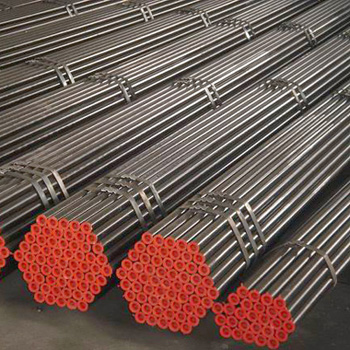 , the less rust inhibitor use, especially taking into account the life cycle cost. Another reason for not using rust inhibitor is worried that the spill caused pollution. Therefore, a need to use the material of the anti-rust agent and economical. Existing pipeline corrosion resistant alloys, including duplex carbon steel, but the drawback is the high cost of materials. Compared with this, the welding of martensitic carbon steels are usually poor and needs to warm up and longer time post-weld heat treatment.Therefore, considering the efficiency of pipe laying, martensitic carbon steel is rarely used in pipelines.However, the martensitic carbon steel having the appropriate carbon dioxide gas corrosion resistance and cheaper than the duplex carbon steel.
, the less rust inhibitor use, especially taking into account the life cycle cost. Another reason for not using rust inhibitor is worried that the spill caused pollution. Therefore, a need to use the material of the anti-rust agent and economical. Existing pipeline corrosion resistant alloys, including duplex carbon steel, but the drawback is the high cost of materials. Compared with this, the welding of martensitic carbon steels are usually poor and needs to warm up and longer time post-weld heat treatment.Therefore, considering the efficiency of pipe laying, martensitic carbon steel is rarely used in pipelines.However, the martensitic carbon steel having the appropriate carbon dioxide gas corrosion resistance and cheaper than the duplex carbon steel.
 , the less rust inhibitor use, especially taking into account the life cycle cost. Another reason for not using rust inhibitor is worried that the spill caused pollution. Therefore, a need to use the material of the anti-rust agent and economical. Existing pipeline corrosion resistant alloys, including duplex carbon steel, but the drawback is the high cost of materials. Compared with this, the welding of martensitic carbon steels are usually poor and needs to warm up and longer time post-weld heat treatment.Therefore, considering the efficiency of pipe laying, martensitic carbon steel is rarely used in pipelines.However, the martensitic carbon steel having the appropriate carbon dioxide gas corrosion resistance and cheaper than the duplex carbon steel.
, the less rust inhibitor use, especially taking into account the life cycle cost. Another reason for not using rust inhibitor is worried that the spill caused pollution. Therefore, a need to use the material of the anti-rust agent and economical. Existing pipeline corrosion resistant alloys, including duplex carbon steel, but the drawback is the high cost of materials. Compared with this, the welding of martensitic carbon steels are usually poor and needs to warm up and longer time post-weld heat treatment.Therefore, considering the efficiency of pipe laying, martensitic carbon steel is rarely used in pipelines.However, the martensitic carbon steel having the appropriate carbon dioxide gas corrosion resistance and cheaper than the duplex carbon steel.
To this end, a steel company in Japan to take a lot of steelmaking technology measures, such as reducing the carbon and nitrogen content, control and adding alloying elements to improve the weldability of martensitic carbon steel, developed with good weldability and corrosion resistance Pipeline martensitic carbon steel seamless pipe.
1 development process
1.1 Target Characteristics
Development goals as follows:
(1) Welding: welding does not require preheating;
(2) the maximum hardness of the heat affected zone: HV350 or less;
(3) corrosion of carbon dioxide corrosion: resistance 5% NaCl, carbon dioxide partial pressure 3.0MPa, 150 ℃ corrosive environment;
(4) resistance to sulfide stress corrosion cracking resistance (SSC): resistance to 5% NaCl, 0.001MPaH2S, pH4.0;
(5) Strength: X80 (550MPa or higher yield strength);
(6) Low-temperature toughness: 100J or the -40 ℃ have higher Charpy impact absorption energy toughness.
1.2 Chemical composition design
The chemical composition of the steel pipe designed to consider the impact of alloying elements on the weldability of martensitic carbon steel, corrosion resistance, thermal processing and other features. Particular welded according to the oil pipes used in the carbon dioxide environment KO-13Cr (0.20C-13Cr-0.03N) the chemical composition, while in the base material to maintain the same level of corrosion resistance. According to Table 1, the results on the chemical composition of thermal processing and other characteristics, the chemical composition of this steel is finalized 12Cr-5Ni-2Mo-0.01N 0.015C or less.
1.2.1 Weldability
Since martensitic carbon present tendency to generate welding cracks in the welding, in practical application to be preheated in order to prevent cracks. The weld cracking is caused by the dissolution of hydrogen in the weld metal and the weld heat affected zone and the heat affected zone of martensitic transformation induced hardening and residual stress. Therefore, effective means to prevent welding cracks in materials is to reduce the content of carbon and nitrogen to suppress due to martensitic phase transformation induced hardening. Table 1 shows for low C + N martensitic carbon steel weld cracking test results of the Y-shaped groove. Carbon or nitrogen of the cracking test steel is 0.03%, while the carbon and nitrogen in the steel will Low to 0.01%, and no cracking test, preheated at 30 ℃. The results indicate that if the carbon and nitrogen content was reduced to 0.01%, welding is possible without preheating. Existing steelmaking technology the content of carbon and nitrogen can be reduced to such a low level.
Table 1 Low C + N martensitic carbon steel Y-shaped groove weld cracking test results
Material
Preheat temperature
30 ℃
70 ℃
100 ℃
0.03C-0.01N
11Cr-1.0Ni-0.5Cu
A crack
A crack
A crack
0.01C-0.03N
11Cr-1.0Ni-0.5Cu
A crack
A crack
A crack
0.01C-0.01N
12Cr-1.0Ni-0.5Cu
No cracks
No cracks
No cracks
12Cr-1.0Ni-1.0Cu
No cracks
No cracks
No cracks
12Cr-2.0Ni-0.5Cu
No cracks
No cracks
No cracks
The thickness of the plate: 15mm
Welding Materials: 410HSMAW 4Ф (diffusible hydrogen; 4.28cm3/100g)
Welding conditions: Current: 160A
Voltage: 24 ~ 26V
Speed: 150mm/min
Test conditions: Room temperature: 30 ℃,
Humidity: 60% RH
1.2.2 resistant carbon dioxide corrosive
Reduce the carbon content but also to improve the steel corrosion resistant carbon dioxide. The tests show that the martensitic carbon steel of different chemical composition having different resistance to carbon dioxide corrosion, the relationship between the corrosion rate and the carbon dioxide index is determined by the Cr-10C +2 Ni. Raise the content of chromium and nickel, and to reduce the carbon content of the steel can be improved resistance to carbon dioxide corrosion. This is probably because of the lower carbon content reduces the content of chromium carbide, thus increasing the amount of dissolution of chromium, and thus effectively prevents corrosion.
1.2.3 resistant to sulfide stress corrosion cracking resistance
Sulfide stress corrosion cracking due to the martensitic carbon steel originating in pitting, improving pitting resistance can improve the resistance to sulfide stress corrosion cracking resistance. Known alloying elements molybdenum can improve the pitting corrosion resistance of the steel. Tests showed that the nickel content is from 4% to 5% of the test results of undifferentiated, and the content of molybdenum from 1% to 2%, the occurrence of sulfide stress corrosion cracking tend to low pH, high hydrogen sulfide partial pressure , or a more hostile environment. This phenomenon shows that adding 1% of molybdenum can be sufficiently ensured in the environment of 5% NaCl, 0.001MPaH2S, pH4.0 the resistance to sulfide stress corrosion cracking, and this is the development of this steel target. However, due to the pitting resistance of the heat-affected zone may be lower than the base metal, add 2% molybdenum to ensure stable pitting resistance.
2 new steel pipe characteristics
The characteristics of the newly developed steel were tested, the sample is a seamless tube, the outer diameter of 273mm, wall thickness of 12.7mm, its chemical composition is shown in Table 2, and the quenching and tempering treatment to obtain the product of X80 grade . This product and 25Cr duplex carbon steel welding materials, first with gas-shielded tungsten electrode arc welding (GTAW), second pass gas shielded metal arc welding (GMAW) ring welds. The chemical composition of the welding material shown in Table 2, the welding conditions are shown in Table 3, the heat treatment is not preheated or welding.
The chemical composition of Table 2 for the base of the annular weld metal and wire wt%
Material
C
Cr
Ni
Mo
N
Matrix metal
<0.015
12
5.1
2
0.01
GTAW welding wire
0.01
25.3
9.5
4
0.27
GMAW wire
0.02
25.1
9.6
4
0.27
Table 3 ring welds conditions
Pass
Welding method
Welding materials
Welding position
Protective gas
Interpass temperature
Electric current
Voltage
Speed
Heat input
A
V
mm / min
kJ / mm
1
GTAW
Ф2.0mm
5G
100% Ar
<25 ℃
148
13.5
44
2.7
2
GMAW
Ф1.2mm
5G
100% Ar
25 ℃
145
15
75
1.7
2.1 Mechanical Properties
Table 4 shows the tensile test results, the strength is set to X80 grade welded joint fracture in the base metal, indicating that higher performance. The cross-section of the welded joints showed that the distribution of the heat affected zone of maximum hardness of about HV330, which meet the requirements of the design goals HV350 or less. The welded joints of the Charpy impact test results indicate that the absorbed energy of about -80 ℃ -40 ℃ 200J, newly developed steels have excellent low temperature toughness.
Table 4 welded joints and the tensile test results of the matrix metal
Material
Yield Strength, MPa
Tensile strength, MPa
Elongation,%
Fracture location
Welded joints
-
856
30
Matrix metal
Matrix metal
634
827
34
-
2.2 resistant carbon dioxide corrosive
Immersion tests carried out in the environment of high temperature and high partial pressure of carbon dioxide, is assessed by measuring the weight loss of the carbon dioxide gas corrosion resistance of the steel. Assumed acceptable corrosion rate of 0.127mm / a newly developed material is adapted to 160 ° C. The, 2.0MPa carbon dioxide partial pressure.
2.3 resistance to sulfide stress corrosion cracking resistance
Using the value carrier tensile sulfide stress corrosion cracking test to evaluate the resistance of welded joints sulfide stress corrosion cracking resistance. The aqueous solution was mixed with 5% or 10% NaCl, 0.5% CH3COOH, using CH3COONa, pH value adjusted to 5.0 from 3.5. The test gas was mixed with the hydrogen sulphide partial pressure of 0.001 ~ 0.007MPa. The applied stress of 567MPa, and the yield strength is equivalent to 90% of the matrix metal. The test results show that the sulfide stress corrosion cracking has occurred although the pH of the heat affected zone of 3.5, but at pH 2.0 and a hydrogen sulfide partial pressure of 0.001MPa environment failed to sulfide stress corrosion cracking occurs.
Girth weld welding intergranular stress corrosion cracking
According to reports, the laboratory study found that in the high-temperature carbon dioxide environment, the annular weld sample intergranular stress corrosion cracking has similar chemical composition and the newly developed steel. In addition, there are reports that, in an actual pipeline molybdenum, similar to the chemical composition of the material and newly developed steel gas leak occurred due to intergranular stress corrosion cracking.
3.1 intergranular stress corrosion cracking mechanism
In order to verify that the welding conditions on the behavior of sensitized, stress corrosion cracking test sample after two passes simulated heat cycle. In order to carry out the harsh conditions of the test, corrosive environment for Quan pH value 2.0, the U-shaped bend test, put greater strain. The test results showed that the number of samples after the heat cycle of the second pass on the cracks. Only after the first pass of the sample did not crack.
These results show that lead to intergranular stress corrosion cracking following reasons: when the high-temperature heating cycle, the carbon is dissolved in the subsequent heat cycles in the original austenite grain boundaries become carbides precipitated in the grain boundary carbides in the vicinity of a chromium depleted zone is formed, thereby enabling the material sensitized.
3.2 to prevent intergranular stress corrosion cracking
Is probably due to the chromium depleted zone intergranular stress corrosion cracking, to prevent intergranular stress corrosion cracks may include post-weld heat treatment to restore the diffusion of chromium, the carbon content is reduced to a very low level, and add titanium to suppress precipitation of chromium carbide.
In order to determine the effects of post-weld heat treatment, the material of the carbon-containing 100ppm of sensitization by two times the heating cycle, followed under different conditions for a third pass of the heating cycle. Similar to the above-described U-shaped bend to the stress corrosion cracking test in order to assess specimen prepared. The test results show that heating in the range of 550 ~ 700 ℃ minutes sensitized specimen without crack.This effect is probably because the heat treatment to increase the diffusion of the chromium, thus narrowing the chromium depleted zone. After a short period of welding heat treatment (a few minutes), you can prevent the intergranular stress corrosion cracking, pipeline laying efficiency without hinder.
In order to determine the lower carbon content, and adding titanium, on different carbon content and the titanium content of the material was evaluated. The sample was 450 ° C, the processing of the 1000s a heating cycle, this condition is liable to cause sensitization, a similar U-shaped bend stress corrosion crazing test. With the change of the test conditions, the gap in the U-shaped curved section of the sample generated. The experimental results show that, to reduce the carbon content, and adding titanium to the generation of cracks can be suppressed. This is probably because of the suppressed during welding of carbon dissolved and converted to titanium carbide may cause the chromium depleted chromium carbide precipitation is suppressed. Therefore, to reduce the carbon content and add titanium is an effective way to improve material resistance to intergranular stress corrosion cracking.
4 Conclusion
new martensitic carbon steel seamless pipe it weldability by reducing the carbon and nitrogen content has been improved, and it has excellent corrosion resistance and mechanical properties by optimizing other alloying elements.
The main features of this new type of steel pipe are as follows:
(1) The new pipe has excellent weldability, even without preheating welding cracks.
(2) the strength of the new steel pipe of X80 grade in low temperature toughness as -40 ℃ Charpy impact test of the absorbed energy is about 200J or more.
(3) The steel having excellent resistance to carbon dioxide corrosion, in 160 ℃ 2.0MPaCO2 environment under the corrosion rate of 0.127mm / a or less.
(4) The steel has excellent resistance to in pH4.0 and 0.001MPa hydrogen sulfide partial pressure environment sulfide stress corrosion cracking resistance.
(5) After a short period of time (a few minutes), post-weld heat treatment to to prevent intergranular stress corrosion cracking. Lower carbon content and add titanium to be effective in improving the material's resistance to intergranular stress corrosion cracking.
This new type of pipe has excellent weldability, mechanical properties and corrosion resistance, can be used to transport containing corrosive gas liquids pipeline, such as carbon dioxide, so it will be a low life-cycle cost economic material.
Copyright (c)2012 LongtaidiIf you do not find the information you need, Click
Here Get Support
New Update Pipe List
-
Water line pipe
Water line pipe Size:4" to 60" carbon steel seamless pipeline, piplines,ERW line pipes,Spiral pipes.SSAW COATING PIPE LINE : [ Spiral Submerged Arc Welding (SAWH) steel pipeline]. Hot rolled seamless steel pipe production
Hot rolled seamless steel pipe production. API 5L Line Pipes X42
API 5L Line Pipes X42,API 5L: A25, A, B, X42, X46, X52, X56, X60, X65, X70, X80 API 5CT: J55 K 55 M65 N80 L 80 C 90 T 95 P110 H40 Q125 CS-90 SCS-95 SCS-80 TCS-110T . API 5l A53 ERW Pipe
API 5l A53 ERW Pipe,ERW steel pipe JCEO Wall thickness:0.5mm-25 ISO,TUV,AD,PED cert. GB/T3091-2001 Material include Q235 20# 16Mn(Q345,Q215) .
Hot Click PRO
-
A53 SCH40 Welded Carbon Steel Pipe
A53 SCH40 Welded Carbon Steel Pipe, Grade: A53 GR. B, API 5L GRB, API 5CT GR. B, ST37, ST52 Outside Diameter: 1/2"-72" Wall Thinkness: 0.5mm-80mm sch40--schXXS.. ANSI steel pipe schedule chart - SCH40 SCH80 seamless ERW pi
ANSI steel pipe schedule chart - SCH40 SCH80 seamless ERW pipe . Thin-walled steel material parameters Reverse
Thin-walled steel material parameters Reverse,Advanced design and manufacture of the State Key Laboratory of auto body Hunan University, Changsha, 4100822. Abstract: identify the problem for thin-walled steel material parameters, using a. ASTM A106/A53 GR.B 32 INCH Carbon Seamless pipe
1. Carbon Seamless Steel Pipes of API 5L/ ASTM A106/A53 GR.B.2. Hot Expanded Seamless Steel Pipes.3. ERW Steel Pipe..
- Carbon steel pipe Standard
- ASTM A106 pipe
- ASTM A53 pipe
- ASTM A192 pipe
- ASTM A252 pipe
- ASTM A179 pipe
- DIN 1629 pipe
- DIN 17175 pipe
- Alloy pipe Standard
- ASTM A335 pipe
- ASTM A210 pipe
- ASTM A213 pipe
- ASTM A234 pipe
- ASTM A519 pipe
- Stainless pipe metrial
- 304, 304L, 304SS pipe
- 310, 310S pipe
- 316, 316L pipe
- Pipe Fitting Metrial
- Carbon steel: A234 WPB pipe
- Stainless steel: 304,316 pipe
- Alloy steel: A234 WP5 WP9 WP11 WP22 pipe


